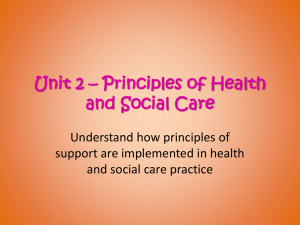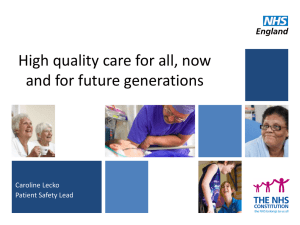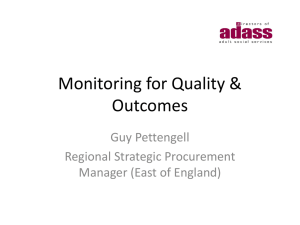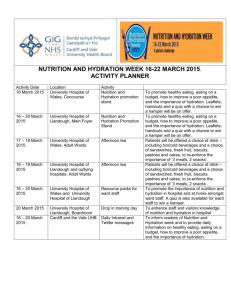Ann Close_9 - Healthcare Conferences UK
advertisement
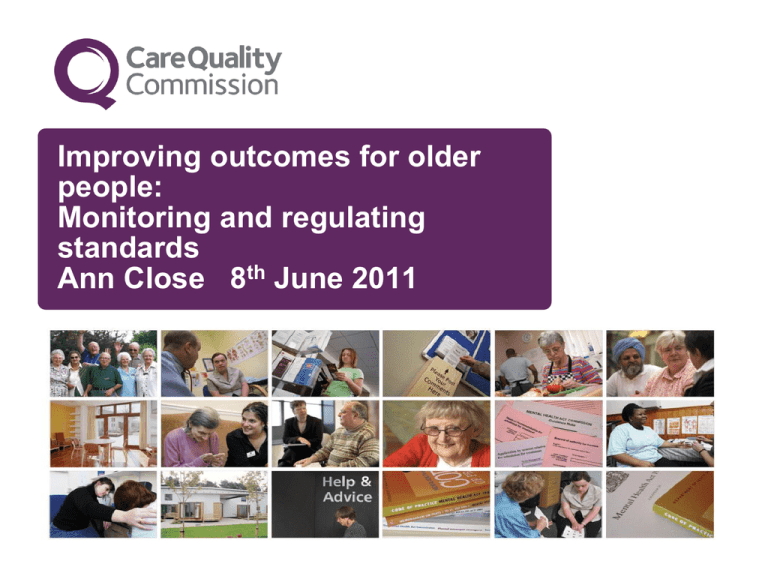
Improving outcomes for older people: Monitoring and regulating standards Ann Close 8th June 2011 Overview • An outcomes focused approach to improvement • Learning from the DANI programme • Involving patients in inspecting service – experts by experience • Safeguarding vulnerable older people 2 Role of CQC • Health and Social Care Act 2008 • Regulation of health and adult social care • Registration of providers • Monitoring compliance with essential standards • Improvement through enforcement action 3 Strategic Priorities Focus on quality and act swiftly to eliminate poor quality care Make sure is centred on people’s needs and protect their rights 4 The scale of regulated care Primary medical services Independent healthcare Independent ambulances 9,000 providers 1,500 providers 200 providers NHS hospitals Adult social care Primary dental care 409 providers 12,500 providers 8,000 providers Combined outpatients and inpatients People using adult social care services Dental appointments 77.4 million 1.75 million 36.4 million Plus additional c700 providers (bodies currently licensed HFEA and HTA) 5 Essential Standards • Regulations • Outcomes - 28 • Prompts - for all providers - for specific services types 6 CQC’s guidance about compliance: example of an OUTCOME Care and welfare of people who use services OUTCOME 4 What should people who use services experience? People using the service: Experience effective, safe and appropriate care, treatment and support that meets their needs and protects their rights That is because providers who are compliant with the law will: Take appropriate steps to ensure people are protected against risks of receiving care or treatment that is inappropriate or unsafe Carry out assessment of all needs, including assessments of risk Plan and deliver care and treatment which meets those needs, ensures safety and welfare Delivers care and treatment that reflects published evidence/guidance of good practice 7 Outcome 5 Meeting nutritional needs Regulation 14 of the Health and Social Care Act • People who use services are supported to have adequate nutrition and hydration Providers who comply will • encourage and support people to receive adequate nutrition and hydration • provide choices of food and drink to meet diverse needs and make sure food and drink is nutritionally balanced and supports their health 8 Outcome 1 – Respecting and involving people who use services Informatio n Involved in decisions Privacy dignity Independence respected Involvement of carers Diversity, human rights Values -recognised Promotion of independence Views taken account of Support for people and carers Service users at centre of care Encourage being an active part of community Involvement on how services run 9 Dignity and nutrition inspection programme Significant reports considered • Still Hungry to be Heard (Age Concern & Age UK, 2010) • Listen to the Patient, Speak up for Change (Patient Association Report, 2010) • Care and compassion? (Health Service Ombudsman Report, 2011) 10 Brief • Request initiated by the Secretary of State for Health – the request being made under section 48 of the Social Care Act • Purpose of the programme is to review the quality of care in relation to dignity, nutrition and hydration needs of older people in NHS hospitals • A 3 month inspection programme to include 100 NHS acute hospitals nationally 11 Dignity and Nutrition Inspection review The inspection team will consist of a expert by experience a senior nurse CQC compliance inspectors •The results of the inspections will be collated into a national report. • Reviews follow CQC normal process of compliance review and a judgement about compliance using the judgement framework will be made •Each organisation will receive a compliance report 12 Learning from the DANI programme - the negative Nutrition •People not being given assistance to eat •Nutritional needs not being assessed and monitored •People not being given enough to eat and drink Dignity •People not involved in own care •Staff not treating people in a respectful way •Staff speaking to people in a condescending and dismissive way 13 Learning from the DANI review - the positives Dignity • Polite, sensitive staff – treated patients with respect and kindness • staff encourage independence but available when needed • Privacy protected • Staff explained and gave information Nutrition • good choice of food and in sufficient quantities • Hand wipes prior to meals • Food hot when served • Patients encouraged to eat “ see if you can eat a little” “do you like this?” 14 Involving experts by experience Patients and nurses •Added value of different perspective •Complements generic inspection •Focus on patients perspective •Clarity re clinical decisions •Learning about regulation 15 What do we mean by safeguarding adults ? The systems, processes and practices in place to enable people to live a life that is free from abuse and neglect through : • ensuring adequate awareness of issues about the abuse of adults • ensuring priority is given to safeguarding people from abuse • helping prevent people experiencing abuse in the first place •recognizing and acting appropriately when there are allegations of abuse and supporting the person who has experienced abuse 16 Key concerns about safeguarding • Confusion about when safeguarding alerts should be made • What incidents should go through SUI process • Confusion about notifications • Lack of preparation re Deprivation of Liberty Safeguards • Lack of clarity about definitions and concepts • Insufficient training • Lack of leadership • Sporadic engagement across services and sectors 17 Responsibilities for providers for improving care for older people Effective leadership at all levels • Creating right sort of culture • Ensuring all health care professionals take responsibility • Ensuring good practice, high standards of clinical care, competent staff and effective partnership working. • Effective communication and feedback • Measuring and monitoring performance • Action and sustained change • 18 Summary Most older people receiving care are vulnerable • Providers are responsible for quality, safe and effective care. • Health care professionals have a key role in protecting older people from unsafe and inappropriate care • Essential standards and outcomes are key measures • Registration is a basic standard • Learning lessons from failings is essential • 19


